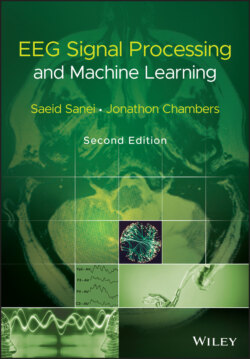Читать книгу EEG Signal Processing and Machine Learning - Saeid Sanei - Страница 62
4 Fundamentals of EEG Signal Processing 4.1 Introduction
ОглавлениеElectroencephalography (EEG) signals are the signatures of neural activities and generally are the integrals of active potentials which elicit from the brain with different latencies and populations around each time instant. They are captured by multiple‐electrode EEG machines either from inside the brain, over the cortex under the skull, or in the majority of applications, certain locations over the scalp. The EEG file formats are different for different recording machines but nowadays they can be easily read or converted by conventional software. The signals are normally presented in the time domain, however, many new EEG machines are capable of applying simple signal processing tools such as the Fourier transform to perform frequency analysis and equipped with some imaging tools to visualize EEG topographies (maps of the brain activities in the spatial domain).
There have been many algorithms developed so far for processing EEG signals. The operations include, but are not limited to, time‐domain analysis, frequency‐domain analysis, spatial‐domain analysis, and multiway processing. Also, several algorithms have been developed to visualize the brain activity from images reconstructed from only the EEGs namely topographs. Separation of the desired sources from the multisensor EEGs has been another research area. This can later lead to the detection of brain abnormalities such as epilepsy and the sources related to various physical and mental activities. In Chapter 17 of this book we will also see that the recent works in brain–computer interfacing (BCI) [1] have been focused upon the development of advanced signal processing as well as the vast advances in cooperative networking and deep learning tools and algorithms.
Modelling of neural activities is probably more difficult than modelling the function of any other organ. However, some simple models for generating EEG signals have been proposed. Some of these models have also been extended to include generation of abnormal EEG signals.
Localization of brain signal sources is another very important field of research [2]. In order to provide a reliable algorithm for localization of the sources within the brain sufficient knowledge about both propagation of electromagnetic waves, and how the information from the measured signals can be exploited in separation and localization of the sources within the brain is required. The sources might be considered as magnetic dipoles for which the well known inverse problem has to be solved, or they can be considered as distributed current sources.
Patient monitoring and sleep monitoring require real‐time processing of (up to few days) long EEG sequences. The EEG provides important and unique information about the sleeping brain. Major brain activities during sleep can be captured using the developed algorithms such as the method of matching pursuit (MP) [3] discussed later in this chapter.
Epilepsy monitoring, detection, and prediction have also attracted many researchers. Dynamical analysis of time series together with application of blind separation of the signal sources has enabled prediction of focal epilepsies from the scalp EEGs. Conversely, application of time–frequency (TF) domain analysis for detection of the seizure in neonates has paved the way for further research in this area. An important recent contribution in the field of epilepsy is how to model the pathways between intracranial epileptiform discharges (mainly during the interictal period) and the scalp electrodes. Recent developments in this area have been made by introducing some new methods such as the multiview approach and dictionary learning [4–6] as well as deep neural network structures [7, 8] which enable capturing a considerable percentage of so‐called interictal epileptiform discharges (IEDs) from over the scalp. This technique is described in Chapters 7 and 11 of this book.
In the following sections most of the tools and algorithms for the above objectives are explained and the mathematical foundations discussed. The application of these algorithms to analysis of the normal and abnormal EEGs however will follow in the later chapters of this book. The reader should also be aware of the required concepts and definitions borrowed from linear algebra. Further details of which can be found in [9]. Throughout this chapter and the reminder of this book continuous time is denoted by ‘t’ and discrete time, with normalized sampling period T = 1, with ‘n’. In some illustrations however the actual timings in seconds are presented.
